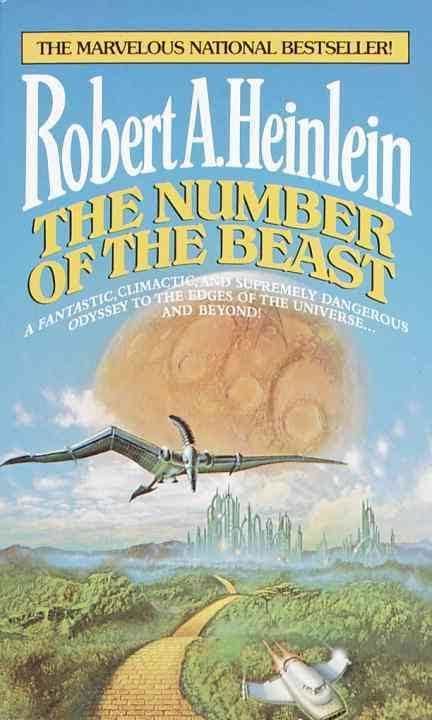7.2 /10 1 Votes7.2
Country United States Media type Print (Paperback) Originally published 12 July 1980 Cover artist Richard M. Powers Genre Science Fiction | 3.6/5 Goodreads Language English Publication date July 12, 1980 ISBN 0-449-13070-3 Preceded by Time Enough for Love | |||||||||||||||||||||||||||||||||
 | ||||||||||||||||||||||||||||||||||
Similar The Cat Who Walks Through, To Sail Beyond the Sunset, Time Enough for Love, Methuselah's Children, Job: A Comedy of Justice | ||||||||||||||||||||||||||||||||||
The Number of the Beast is a science fiction novel by American writer Robert A. Heinlein, published in 1980. The first (paperback) edition featured a cover and interior illustrations by Richard M. Powers. Excerpts from the novel were serialized in the magazine Omni (1979 October, November).
Contents
Plot
The book is a series of diary entries by each of the four main characters: Zebadiah John Carter, programmer Dejah Thoris "Deety" Burroughs Carter, her mathematics professor father Jacob Burroughs, and an off-campus socialite Hilda Corners. The names "Dejah Thoris", "Burroughs", and "Carter" are overt references to John Carter and Dejah Thoris, the protagonists of the Barsoom novels of Edgar Rice Burroughs.
The four travel in Zebadiah's modified air car Gay Deceiver, which is equipped with the professor's "continua" device and armed by the Australian Defence Force. The continua device was built by Professor Burroughs while he was formulating his theories on n-dimensional non-euclidean geometry. The geometry of the novel's universe contains six dimensions; the three spatial dimensions known to the real world, and three time dimensions - t, the real world's temporal dimension, τ (tau), and т (teh). The continua device can travel on all six axes. The continua device allows travel into various fictional universes, such as the Land of Oz, as well as through time. An attempt to visit Barsoom takes them to an apparently different version of Mars seemingly under the colonial rule of the British and Russian empires; but near the end of the novel, Heinlein's recurring character Lazarus Long hints that they had traveled to Barsoom, and that its "colonial" status was an illusion imposed on them by the telepathically adept Barsoomians:
... E.R.B.'s universe is no harder to reach than any other and Mars is in its usual orbit. But that does not mean that you will find Jolly Green Giants and gorgeous red princesses dressed only in jewels. Unless invited, you are likely to find a Potemkin Village illusion tailored to your subconscious....
Title
In the novel, the biblical number of the beast turns out to be not 666 but
Writing style
The novel lies somewhere between parody and homage in its deliberate use of the style of the 1930s' pulp novels. Many of the plot lines and characters are derived directly from the pulps, as referenced by the first line of the novel:
He's a Mad Scientist and I'm his Beautiful Daughter.
The Number of the Beast contains many in-jokes and references to the author. The name of every villain is an anagram of a name or pen name of Robert or Virginia Heinlein.
As in many of his later works, Heinlein refers to the idea of solipsism, but in this book develops it into an idea he called "World as Myth" — the idea that universes are created by the act of imagining them, so that all fictional worlds are in fact real and all real worlds are figments of fictional figures' fancy, which is why Heinlein uses the Ouroboros symbology in later works like The Cat Who Walks Through Walls. This also plays into the ideology of "Thou Art God" from Heinlein's earlier work Stranger in a Strange Land.
Literary significance and reception
Jack Kirwan wrote in the National Review that the novel is "about two men and two women in a time machine safari through this and other universes. But describing The Number of the Beast thus is like saying Moby Dick is about a one-legged guy trying to catch a fish". He goes on to say that Heinlein celebrates the "competent person".
Sue K. Hurwitz said in her review for the School Library Journal that it is "a catalog of Heinlein's sins as an author; it is sophomoric, sexist, militantly right wing, and excessively verbose", and comments that the book's ending was "a devastating parody of SF conventions—will have genre addicts rolling on the floor. It's garbage, but right from the top of the heap".
Heinlein buff David Potter explained on alt.fan.heinlein in a posting reprinted on the Heinlein Society that the entire book is actually "one of the greatest textbooks on narrative fiction ever produced, with a truly magnificent set of examples of HOW NOT TO DO IT right there in the foreground, and constant explanations of how to do it right, with literary references to people and books that DID do it right, in the background." He noted that "every single time there's a boring lecture or tedious character interaction going on in the foreground, there's an example of how to do it RIGHT in the background."
